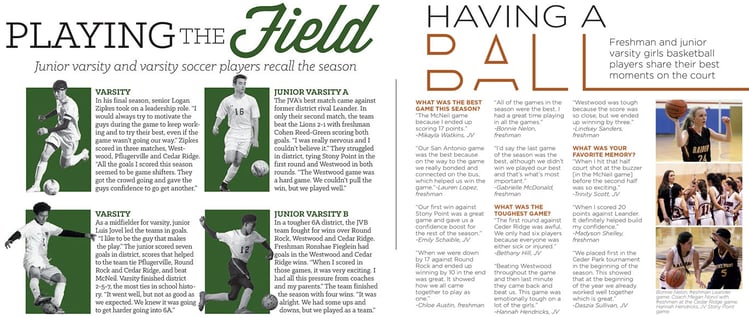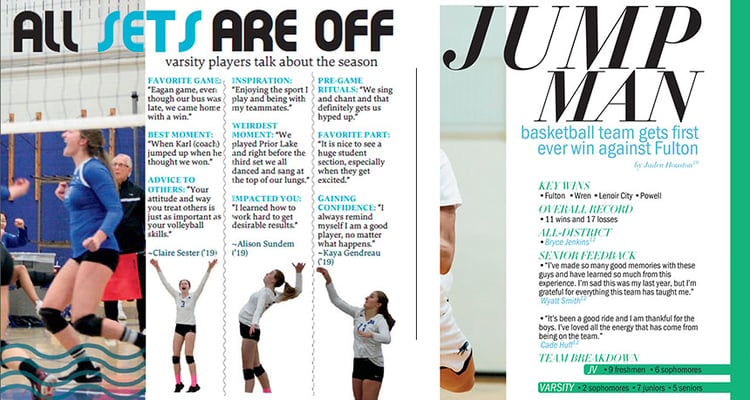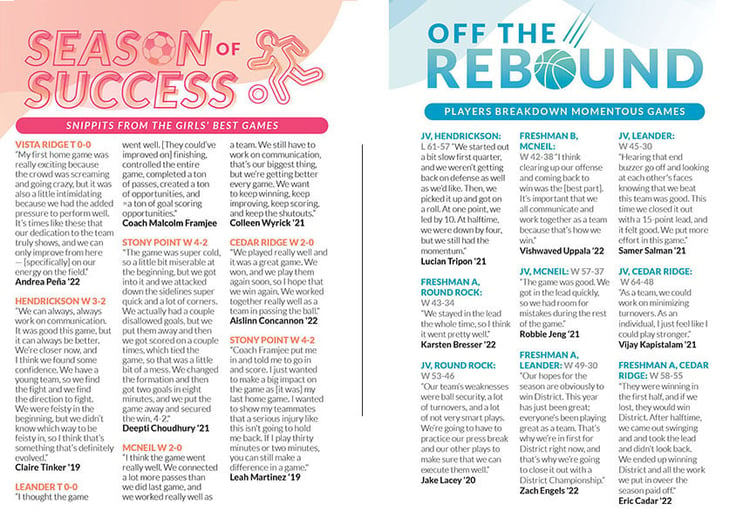
Sports coverage shouldn’t be terrible. But often our unfamiliarity with sports terminology or the season’s outcome results in vague or fluff-filled stories. Worse, sometimes the story is omitted entirely, excluding historical data from the only permanent record of the year.
We need to change our strategy. We need authentic sports coverage that truly covers the season. We need alternative copy.
Alternative copy
Alternative copy is like it sounds—an alternative to body copy. Instead of running a traditional story, alternative copy is substituted in the same location. The story can be replaced with a variety of copy formats, but three styles work well for sports alternative copy.
Mini-stories: These are smaller versions of feature stories, often three to five sentences. Mini-stories are ideal for providing snapshots of each game, focusing on key moments. They are also beneficial when needing to cover multiple teams on one spread. One or two quotes sprinkled into the mini-story expand on the game details and add additional students in the book.
 Rouse High School has used alternative copy for the last seven years to create authentic and layered sports coverage. Mini-stories allow multiple teams to be covered on the same spread while Q&As guarantee multiple, additional athletes are included.
Rouse High School has used alternative copy for the last seven years to create authentic and layered sports coverage. Mini-stories allow multiple teams to be covered on the same spread while Q&As guarantee multiple, additional athletes are included.
Q&A: Question and answer story formats are one of the easiest ways to incorporate alternative copy into the sports section. Questions should focus on the season, by asking about the best games, funniest moments and behind the scenes details. Having multiple athletes answer the same question ensures more of the team will be included on the spread.
Highlights: A simplified version of a Q&A, highlights skip the question part and use a concise phrase as the prompt. Multiple athletes can answer each highlight or one player can be featured per highlight. Topics range, but can include best game, most challenging game, pre-game ritual, team hype song and overall season thoughts. A twist on the highlight type of alternative copy is for the prompt be a specific game or match. The quote then reflects on that win or loss.
 Minnetonka High School (left) used highlights to feature three volleyball players. Note how each prompt is different so it’s not the same questions repeated for all three athletes. Hardin Valley Academy (right) used an overall approach, including key games and senior thoughts.
Minnetonka High School (left) used highlights to feature three volleyball players. Note how each prompt is different so it’s not the same questions repeated for all three athletes. Hardin Valley Academy (right) used an overall approach, including key games and senior thoughts.
Why it works
Staffers tend to struggle with writing long stories and readers tend to eschew them. Alternative copy provides, short, quick read options for readers to pop in and out of. Moreover, they allow for additional students to be included on the spread. (We’re a big fan of including athletes not already featured in the photos, ensuring more of the team is covered.)
While alternative copy is not less work than writing a traditional story, it is easier. Staffers will be more successful gathering Q&As and highlights, especially for lesser-understood sports, subvarsity teams and losing seasons.
 Using the score as a highlight prompt is a smart way to cover the season and include multiple students. Westwood High School featured seven athletes on the girls soccer spread and nine players on the subvarsity boys basketball spread.
Using the score as a highlight prompt is a smart way to cover the season and include multiple students. Westwood High School featured seven athletes on the girls soccer spread and nine players on the subvarsity boys basketball spread.
Alternative copy can elevate sports coverage, but it’s not the only option. A traditional story is a better choice when there’s a substantial story to tell—a team winning a conference championship, an athlete advancing to the state tournament, a long run in the playoffs.
Either way, it’s essential to focus on the real moments in the season to provide an authentic account. Details, statistics and hearty quotes will make the copy rich and vibrant. Because, what’s your alternative?

